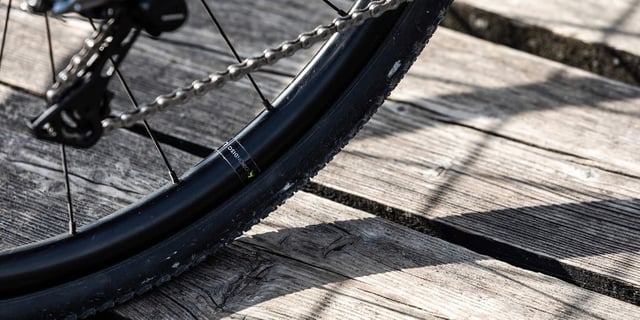
Cyclocross offers numerous benefits for physical fitness. There are also the mental and psychological benefits that such an enjoyable and challenging sport brings to professionals and amateurs alike.
But what is cyclocross good for, and what's the best way of training? Here - in brief - is everything you need to know to turn the sport into a lifestyle that's good for mind and body, heart and muscles.
Cyclocross and training: an old story
Not many people know that cyclocross started as a form of off-season winter training for road cyclists, around the start of the 20th century.
During the winter break in competitions and training, cyclists used to ride in woods, on fields and grassy slopes. This type of terrain forced them to pedal fast and strong, the perfect way to train for short bursts of power and stay in peak fitness for the summer road season.
What's more, as some sections were not accessible on two wheels, the riders often had to get off and carry their bikes. Today this is a feature that distinguishes cyclocross from all other cycling disciplines.
This kind of training remains extremely useful: it is not uncommon for cyclocrossers (even elite athletes) to only practise during the winter months, switching in summer to road cycling or MTB.
The physical benefits
Cyclocross has significant benefits for physical fitness in terms of cardiovascular training, muscle power and endurance.
Here are the main benefits of cyclocross:
- It improves heart capacity
Cyclocross courses require sudden gear changes and power surges, lead the body to use varying levels of force. The heartbeat changes with these variations, increasing and then decreasing when resting. In healthy, fit individuals, cyclocross is a valuable cardio training activity which improves heart function, in other words the ability of the heart muscle to pump blood to all tissues, particularly the muscles involved in cycling. - It increases lung capacity and oxygen consumption (Vo2MAX)
Endurance disciplines like cyclocross improve the lungs' ability to exchange oxygen for CO2 in order to supply the tissues. Specifically, it increases a value known as Vo2MAX: the maximum capacity to consume oxygen during exercise, expressed in millilitres per minute. Since during physical activity oxygen is essential to nourish muscle tissue under strain, a high Vo2MAX level indicates good cardiovascular capacity in the athlete; - It increases the anaerobic threshold, making the muscles stronger and more resistant.
A third physical benefit of cyclocross is that is raises the anaerobic (or lactate) threshold, making muscles stronger and more resistant during intense and prolonged physical activity.
The anaerobic threshold is a value that varies between individuals and represents the borderline between aerobic physical activity (in which the athlete works with well-oxygenated tissues) and anaerobic activity (in which oxygen consumption is very high).
The anaerobic threshold can be moved by training. For example, in non-trained people, the anaerobic threshold corresponds approximately to 50-55% of oxygen consumption per minute (Vo2MAX). Trained athletes, on the other hand, have to use 85% of available oxygen to pass the anaerobic threshold.
Beyond the threshold, physical activity is called intense, and the muscles consume some nutrients present in the blood, producing a reserve substance called lactic acid. The accumulation of lactic acid in the muscles causes pain and cramping, forcing the athlete to stop and rest.
How to train for cyclocross
So we have seen that training for cyclocross can be a cure-all for the most important physical performance needed during intense activity. How can we train for cyclocross?
First and foremost, you can't start from zero. Before embarking on a specific training programme for endurance and technique, it's a good idea to follow an athletics training plan and lay the foundations for withstanding this physical effort.
Cyclocross is an extremely tough sport which requires intense, constant training, repeated 4 or 5 times a week. No untrained person can handle a cyclocross race without risking their health.
The ideal solution would be to rely on an athletics specialist or a personal trainer, and establish a two-step training programme for cyclocross:
- Basic physical preparation;
- Cardio and muscle strengthening.
The third step is technical preparation, with training on road bikes or on cyclocross courses.

What should not be missing in your cyclocross training schedule
If we had to say what shouldn't be missing in your cyclocross training schedule, the answer would be:
- Resistance training, with short bursts of pedalling and hard gear ratios to simulate the type of effort the muscles face when racing. In this case alternative high-intensity activity with pauses can be used, or pyramid repetitions, in which resistance on the pedals is inversely proportional to the time used for each repetition. This type of training has a positive impact on the anaerobic threshold;
- Aerobic training and cardio, including cross-training plans with swimming, running or road cycling. This type of training teaches the body to consume more oxygen, increasing Vo2MAX. Cardio training regulates heartbeat and optimises rhythm and recovery times;
- Technical training on roads or tracks, to learn to handle the bike on muddy and precipitous terrain. This technical training improves factors such as agility and responsiveness during the race.
Cyclocross: where to train
As we have seen, cyclocross training is not only in bike parks or special courses. Cyclocrossers also train in the gym, pool and roads, using weights, exercise bikes, swimming and running. And also long cool-down bike rides, if possible to finish each training session.
For technical training, there are special courses for cyclocross. These are circuits designed specifically to simulate the race course, or bike parks shared with mountain bikers and road cyclists. There are several of these spread across the country.
Some athletes prefer to use country roads or natural trails suitable for cyclocross.
Now you know all the physical benefits of cyclocross, all you need to do is experiment and see that it's also good for mental health, for enjoyment and self-fulfilment.
What is behind a cyclocross wheel and what should you know to choose the best wheel for your needs?
Find out in this interview with Andrea Zen, Ursus engineer




